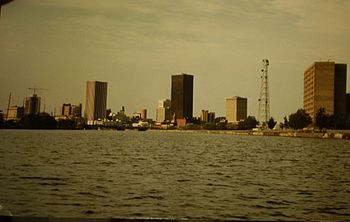History of Rochester, New York
It became a major manufacturing center, and attracted many Italians, Germans, Irish and other immigrants, as well as a dominant group of Yankees of New England origin.
In the 1970s it became fashionable to use the term "Rust Belt" for the industrial cities along the Great Lakes following the move away from steel, chemical and other hard goods manufacturing.
Rochester, with the presence of Ritter-Pfaudler, Bausch and Lomb, Eastman Kodak, Xerox, Gannett and other major industries, defied the trend for many decades following World War II.
Additional Phelps and Gorham lands east of the Genesee River which had not previously been sold, were acquired by Robert Morris in 1791, who re-sold them to The Pulteney Association, a syndicate of British investors.
On November 8, 1803, The Pulteney Association sold the 100-acre (0.40 km2) Tract for $1,750, on a five-year land contract, to Col. Nathaniel Rochester (1752–1831), Maj. Charles Carroll, and Col. William Fitzhugh, all of Hagerstown, Maryland.
When Irish Catholics started to arrive in large numbers in the 1840s and supported the Democrats, the two Protestant groups stopped feuding and presented a common front.
[2][full citation needed]Col. Rochester and his two partners allowed the millsite to lie undeveloped until 1811, when they finally completed paying for their purchase and received the deed.
Members paid twenty-five cents per year to belong to the Society and also contributed provisions, clothing, and bedding which they collected from the community.
The first ten days the canal was open east to the Hudson, 40,000 barrels (3,600 tons) of Rochester flour were shipped to Albany and New York City.
The Athenaeum charged members a five-dollar annual fee to hear lectures by some of America's best-known orators including Oliver Wendell Holmes Sr., Horace Greeley and Ralph Waldo Emerson.
Grog shops were closed; the Sabbath was honored; the sanctuaries were thronged with happy worshippers; a new impulse was given to every philanthropic enterprise; the fountains of benevolence were opened, and men lived to good.By 1834, some 20 flour mills were producing 500,000 barrels (44,000 t) annually, the population reached 13,500 and the city area expanded to 4,000 acres (16 km2).
[citation needed] Douglass stated "I know of no place in the Union where I could have located at the time with less resistance, or received a larger measure of sympathy and cooperation.
"[6] However, on his arrival, he found "barriers erected against colored people in most places of instruction and amusement in the city, and until I went there they were imposed without any apparent sense of injustice and wrong."
In October, 1858, William H. Seward, a leading opponent of slavery, delivered a speech to an overflowing Republican crowd in Corinthian Hall.
"[9] In the years leading up to the Civil War, numerous locations in the Rochester area were used as safe houses to shelter fugitive slaves before they were placed on board boats (often on the Genesee River) for transport to Canada.
The Rochester convention elected a woman as its presiding officer, a highly controversial step at the time that was opposed even by some of the meeting's leading participants.
During this period the city expanded dramatically in area on both sides of the Genesee River, as well as annexing parts of the towns of Brighton, Gates, Greece and Irondequoit.
In September 1885, a group of Rochester businessmen founded the Mechanics Institute to establish "free evening schools in the city for instruction in drawing and such other branches of studies as are most important for industrial pursuits of great advantage to our people."
The Court Street Dam was also built in 1918 to raise the level of the river to that of the Barge Canal so no aqueduct or locks are necessary, but in so doing the Upper Falls and the Castelton Rapids were obliterated.
In 1925, the university opened its Medical School and Strong Memorial Hospital on Crittenden Road, and by 1927, general construction had begun on the River Campus.
These included Gleason Works, Stromberg-Carlson, Taylor Instrument, Ritter Dental Equipment, Rochester Products Division of General Motors, and Pfaudler-Permutit.
This led to a reappraisal of old-time policies and practices which had not changed in face of a tripling of the African American population in 10 years, who were still mostly assigned to low-pay and low-skill jobs and lived in sub-standard housing.
WHAM hired Vic Mason and later Lou Paris, but the real change in black relations came when FM WCMF brought in Herb Hamlett who aired a morning R&B show six days a week.
[citation needed] It was also in the 1960s that the city began a process of urban renewal, with the construction of Midtown Plaza, the first indoor shopping mall in a traditional downtown area in the United States.
The move to a more spacious location was critical to RIT's 1966 selection as the site for the National Technical Institute for the Deaf, and the 1,300 acre (5.3 km2) campus in suburban Henrietta opened in 1968.
The Pythodd was one example of a top Clarissa Street "joint" that hosted jam session including everyone from Little Stevie Wonder to Jimmy Smith and the Mangione brothers (Chuck and Gap).
[27][full citation needed] In the 1990s, a new baseball stadium, Frontier Field, was built for the Rochester Red Wings near the Kodak office building.
The City sold the Spirit of Ontario I at a financial loss in 2007 to the German company Förde Reederei Seetouristik Gmbh & Co (FRS) for $29.8 million (US).
[citation needed] In 2006, a new stadium funded by private and public sources, PAETEC Park, was opened, not far from Frontier Field, and became the home of the Rhinos professional soccer team.
Under Warren, a project to fill in the Inner loop and convert it to a boulevard was undertaken and a plan to build a performing arts center on a parcel of the former Midtown Plaza is underway.












